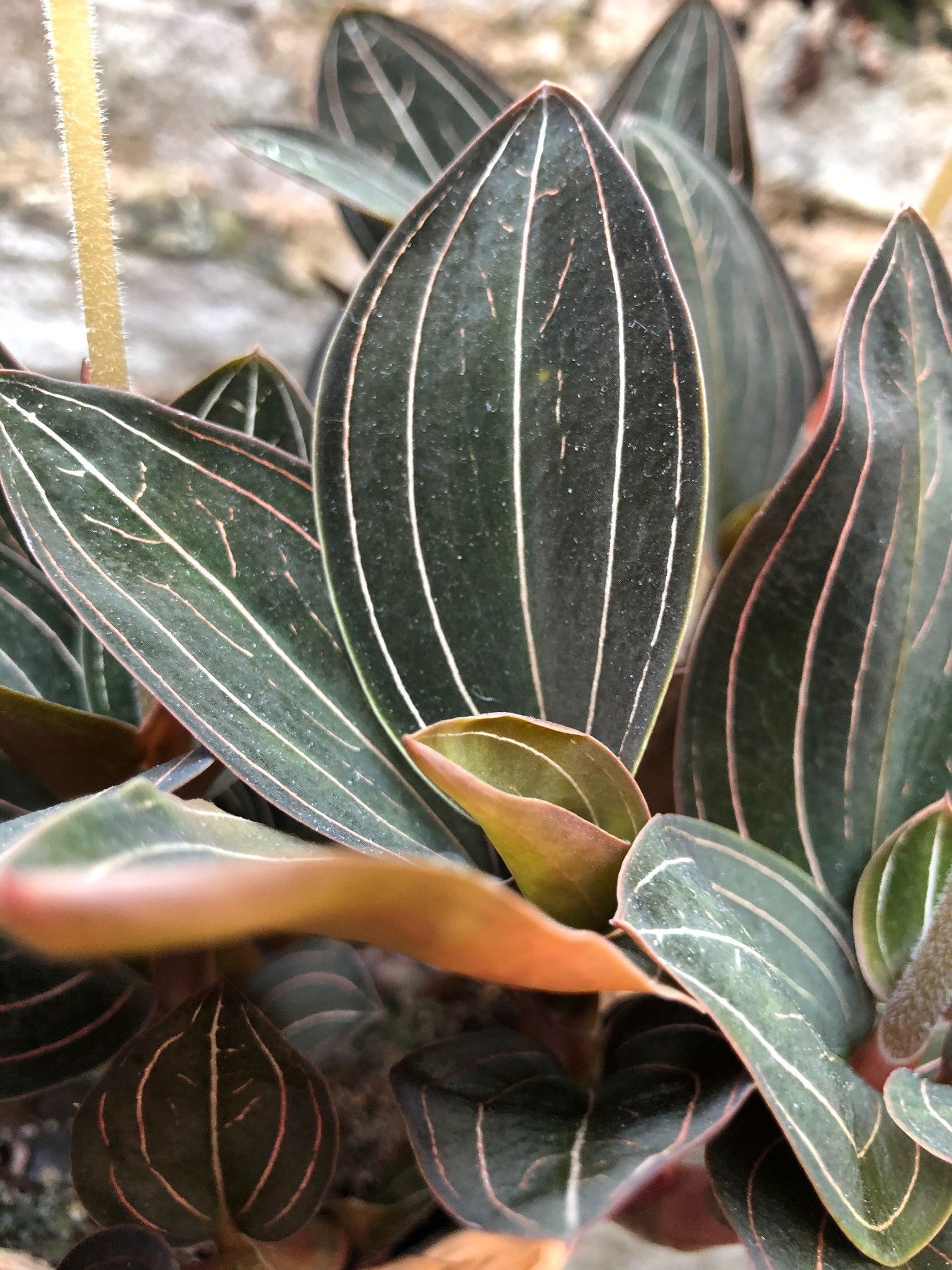
Ludisia discolor
Contents
- Top Tips
- Location, Water, Humidity & Fertilisation
- Dormancy Care & Annual Flowers
- Common Issues
- Origins, Temperature, Propagation, Repotting & Toxicity.
Need the answer to a specific plant query? Book a 1-to-1 video call with THE HOUSEPLANT DOCTOR™, the website's friendly author, to overcome and address your niggling problem! Available on iMessage, WhatsApp, Facebook Messenger & more.
Top Tips & Info
- Care Difficulty - Very Easy
- Situate in a bright, indirect windowsill or under a grow light that's away from the sun or operating heat sources. As Jewel Orchids grow terrestrially along the floor in the wild, they can be accepted as a shade-tolerant plant.
- Avoid persistent droughts and the use of cold water, especially while it's in bloom.
- Keep the soil evenly moist, allowing the top third to dry out in between waters.
- Supplement with a houseplant-labelled fertiliser every two or four weeks depending on the season.
- 'Dormancy Care & Annual Bloom' will talk about acing its dormancy period for achieving flowers each winter.
- Repot every three years in spring, using a 'Houseplant' compost and the next sized pot.
- Keep an eye out for Mealybugs that'll infest the cubbyholes of the stem and leaves with white cottony webs.
Location & Light - 🔸
Anywhere that has an absence of direct sunlight is perfect for this species. Darker settings are tolerable as naturally, they'll grow along the dense jungle floor in South-East Asia. If you're worried about its location being too dark, if a newspaper can be read while having your back towards the light source, you're good to go.
In terms of the ideal room around the house, as long as the desired location is above 15ºC (59ºF) and is at least four metres away from an operating heat source, it should be fine. Never place it in more than an hour of direct sunlight as irreversible damage may occur, in the likes of yellow, mottled leaves.
Water - 🔸🔸
Jewel Orchids love moist conditions. Once the top third of the soil has dried out, give it another soak of water, allowing the excess moisture to drain from the pot freely. Whilst in bloom, it's important not to use cold water as this could shock the roots, causing multiple issues down the line. Under-watering symptoms include rapid flower loss and dry, sunken leaves; these issues are usually due to either forgetfulness, too much sunlight or too much heat. Over-watering symptoms include rotting lower leaves, yellowing leaves, a loss of buds or flowers, and root rot. Allow the majority of the soil to dry out in between waters, preventing a pool of standing water from accumulating beneath the pot.
Humidity - 🔸🔸
Average room humidity is more than enough to occupy a Jewel Orchid, as too high humidity and poor air circulation will result in powdery mildew. Do not mist the flowers as it'll cause botrytis petal blight that can spread quickly. If you're feeling extra, introduce a pebble tray to maintain a reliable level of surrounding moisture; however, this isn't a necessity.
Fertilisation - 🔸🔸
Use a fertiliser high in potassium to prolong its blooms during the flowering period - an excellent example would be a Tomato Feed. Regular 'Houseplant' fertilisers, for instance, BabyBio or Miracle-Gro, will still do the job but will favour foliar growth as well. Reduce this to monthly intervals during the dormancy period, except for when it's in bloom in the winter.
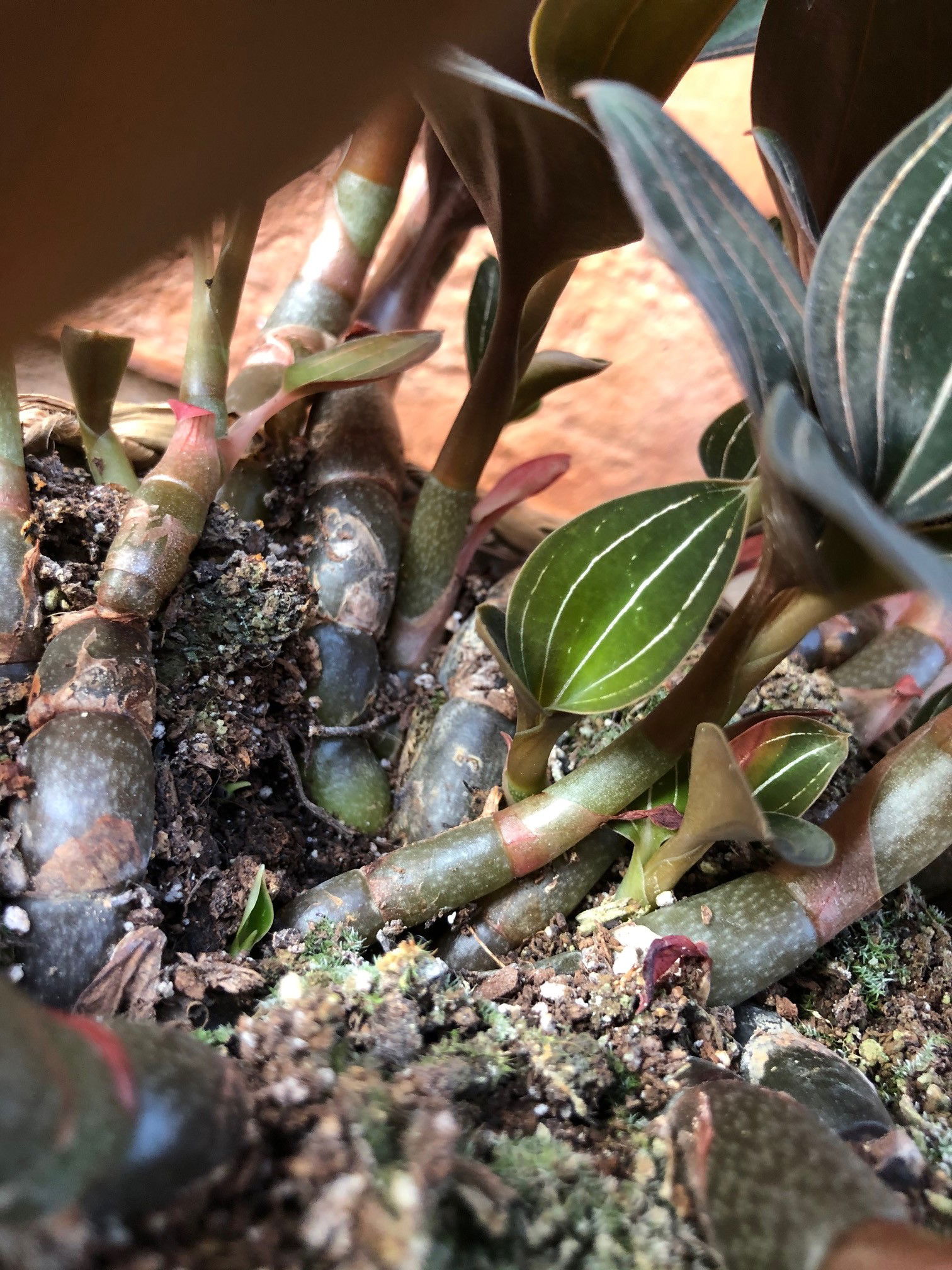 Jewel Orchids are sympodial, meaning that they'll grow laterally along the jungle floor and enabling them to thrive in the darkest of locations.
Jewel Orchids are sympodial, meaning that they'll grow laterally along the jungle floor and enabling them to thrive in the darkest of locations.
Dormancy Care & Annual Flowers
Jewel Orchid blooms are easily achieved when its dormancy irrigations are reduced by half; those who have a cooler room without artificial light at night will also be on the upper-hand. Keep the roots pot-bound to add further stress onto the specimen, which in turn will significantly heighten the chance of flowering. Blooms will generally appear in the winter, but may occur at any given time.
The following steps should be done at the start of autumn until early spring when growth begins to slow. Always think of ukhouseplants' acronym of SHORT when it's time for flowers.
Sunlight & Location
Be sure to provide a bright location with little to no direct sunlight. Although the winter rays won't necessarily hurt the plant, be careful not to fall in the trap of sun-scorch and severe dehydration.
For it to fully become seasoned, avoid the use of artificial lighting or locations that boast temperatures higher than 18℃ (64℉).
Hydration
Reduce waters so that about half of the soil becomes dry. It's essential to keep them on the drier side to life, as they'll think that hard times are ahead and therefore will need to pass its genes on to the next generation.
Occasional Feeds
Whilst in bloom, use a Tomato feed to provide monthly nourishment of potassium; the use of fertiliser isn't needed until the first spike emerges from the stems.
Reduce Everything
This one is to remind you that everything needs to be reduced - especially the temperature.
Temperature
This is the most significant step - reduce the temperature down by around 5℃ compared to the summertime or place in a room that's around 15℃ (59℉). The drop in temperature should ideally last until the inflorescence finishes blooming, although it can still be transferred into the main house as long as it sits on a pebble tray. You'll be at a significant disadvantage if the ambient temperature is kept constant throughout the year, as Orchids will only respond with flowers in cooled environments. Never exceed the minimum temperature as it could lead to plant death or yellowed foliage at a bare minimum.
Common Issues with Jewel Orchids
The Causality of Jewel Orchids with yellowing leaves isn't easy to accurately pinpoint as it could be due to many reasons. If the lower leaves are yellowing in quick concession, over-watering may be to blame. Do not allow the soil to become soil or waterlogged as failure to do so will cause anaerobic (oxygen-lacking) conditions that aren't acceptable with Jewel Orchids. For severe cases, take the plant out of rot pot to examine for root rot - repotting may have to be performed. Another reason could be due to either too much sunlight or not enough soil moisture. Under-watering can cause a Jewel Orchid to slip into its dormancy period. Still, persistent droughts with direct sunlight will cause further damage in the likes of yellowing leaves, stunted growth and wilting.
Too low humidity can cause browning leaf tips with yellow halos and stunted flowers. Although this won't kill your specimen, you may want to increase the local moisture to prevent the new growth from adopting these symptoms. Mist or rinse the foliage from time to time and create a humidity tray whilst the heaters are active to create a stable environment for your specimen.
 Brown/red dehydrated leaves on your Jewel Orchid is nothing to worry about as the plant is just maturing. The individual leaf will only have a certain life-span before dying, and this is the colour it'll become. Simply prune the leaf off once it becomes red/brown to improve the plant's overall appearance!
Brown/red dehydrated leaves on your Jewel Orchid is nothing to worry about as the plant is just maturing. The individual leaf will only have a certain life-span before dying, and this is the colour it'll become. Simply prune the leaf off once it becomes red/brown to improve the plant's overall appearance!
Always use lukewarm water, and if you choose to use tap water, allow it to stand for at least 24hrs before application. Orchids tend to be quite sensitive to temperature change, so pouring cold tap water immediately into the pot will not only ionise your roots but could even cause yellow edges, sudden flower loss and stunted growth.
Never allow temperatures to dip below 10ºC (50ºF) as irreversible damage will occur in the likes of yellow foliage and weakened health. When this happens, remove the severely affected areas and immediately improve growing conditions - never cut through softened yellow growth, and only around brown, crispy squares. As rehabilitation can take several months because of its slow-growing nature, be sure to provide a stable location with better growing conditions to speed this process.
Pests could also be an issue, most notably being Mealybugs. Especially before purchasing, have a quick scan over the plant's foliage and flowers, inspecting its cubbyholes for those white critters. If yours has fallen foul of pests, click on the appropriate links to learn more about treatment as well as observing their appearance.
Too much sunlight will lead to sun scorch, with typical signs including browning or crispy leaves, dry leaf-edges, sunken leaves or stunted growth. Although too little light will cause over-watering issues, too much sunlight will be a detriment, too. If yours has fallen short of this, reduce the amount of sunlight considerably and always be mindful of environmental shock (when too locations offer too different growing conditions). Remove some of the affected leaves and increase waters slightly. Only hydrate the plant using the bottom-up method.
A lack of flowers is caused by an insufficient dormancy period, served in the summer. Locations that offer near-similar temperatures all year round won't allow the plant to go dormant. To achieve, situate in a location that dips to around 15°C (59°F) with fewer waters during the autumn months. Allow the majority of the compost to dry out and provide a humidity tray while the radiators are operating. While we're on the subject, if you'd like to prolong the flowering period, use a fertiliser high in potassium to promote longer-lasting flowers; Tomato Food is an excellent choice. Other tips to extend this period are to avoid temperature fluctuations and droughts, maintain good humidity and place in a well-lit room with little to no direct sunlight.
If your Jewel Orchid is losing leaves and hasn't flowered for a while, this could be due to root rot. THE HOUSEPLANT DOCTOR™ recommends to check the root system for any sign of rot. If so, prune the dead roots with a clean pair of scissors and leave the healthy roots attached to the plant. If the healthy roots are still 'holding on to' any clumps of soil, keep them attached and don't pull them apart (to avoid causing 'transplant shock'). Once you have cut the dead roots away, decide how much of the rootball is remaining and if more than half has been pruned off, it's advised to repot using a 2-5cm narrower pot than its orignal.
Note: If most of the rootball is still healthy and you have only removed a small portion of root rot, THE HOUSEPLANT DOCTOR™ recommends to repot back into its orignal pot with some fresh soil to replace any lost during this process.
Short-lived flowers could be the product of low humidity. Place the Jewel Orchid on a humidity/pebble tray, keeping the reservoir topped up with water throughout the winter. Other ways to increase the surrounding moisture are to situate in a bathroom, or at least three metres away from an operating heat source. Never mist the flowers due to the high risk of developing botrytis.
 The development of buds along a shaft, that'll emerge from the centre of each stem, pictured below.
The development of buds along a shaft, that'll emerge from the centre of each stem, pictured below.
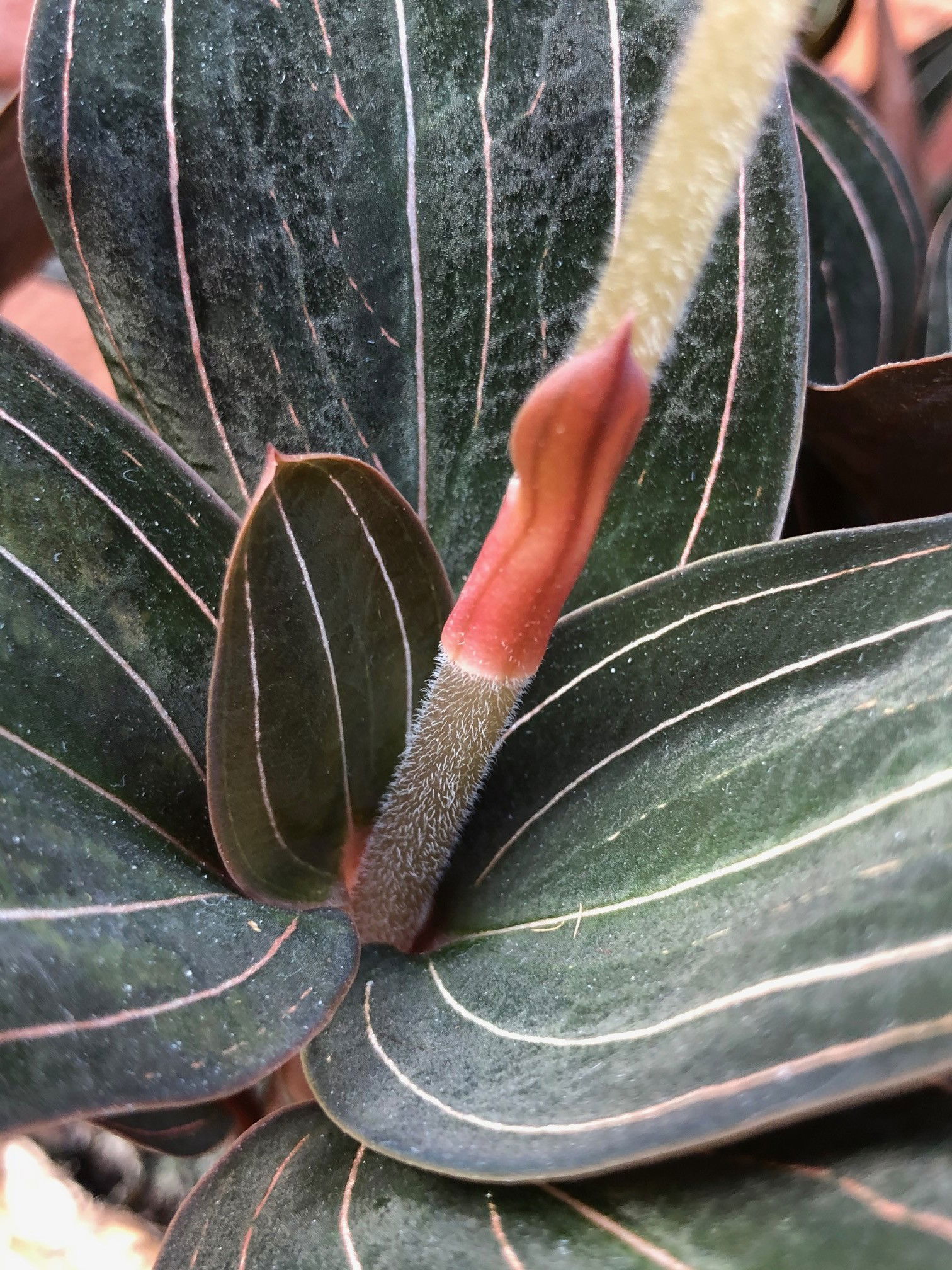 Ludisia discolor
Ludisia discolor
 Ludisia discolor
Ludisia discolorOrigins
Similar to other indoor Orchids, the Ludisia discolour has native origins to tropical locations in South-East Asia. The species was initially described by John Ker-Gawler in 1818 as Goodyera discolor, but was subsequently moved into its own genus by Achille Richard seven years later. His reasoning for the name is still unclear today.
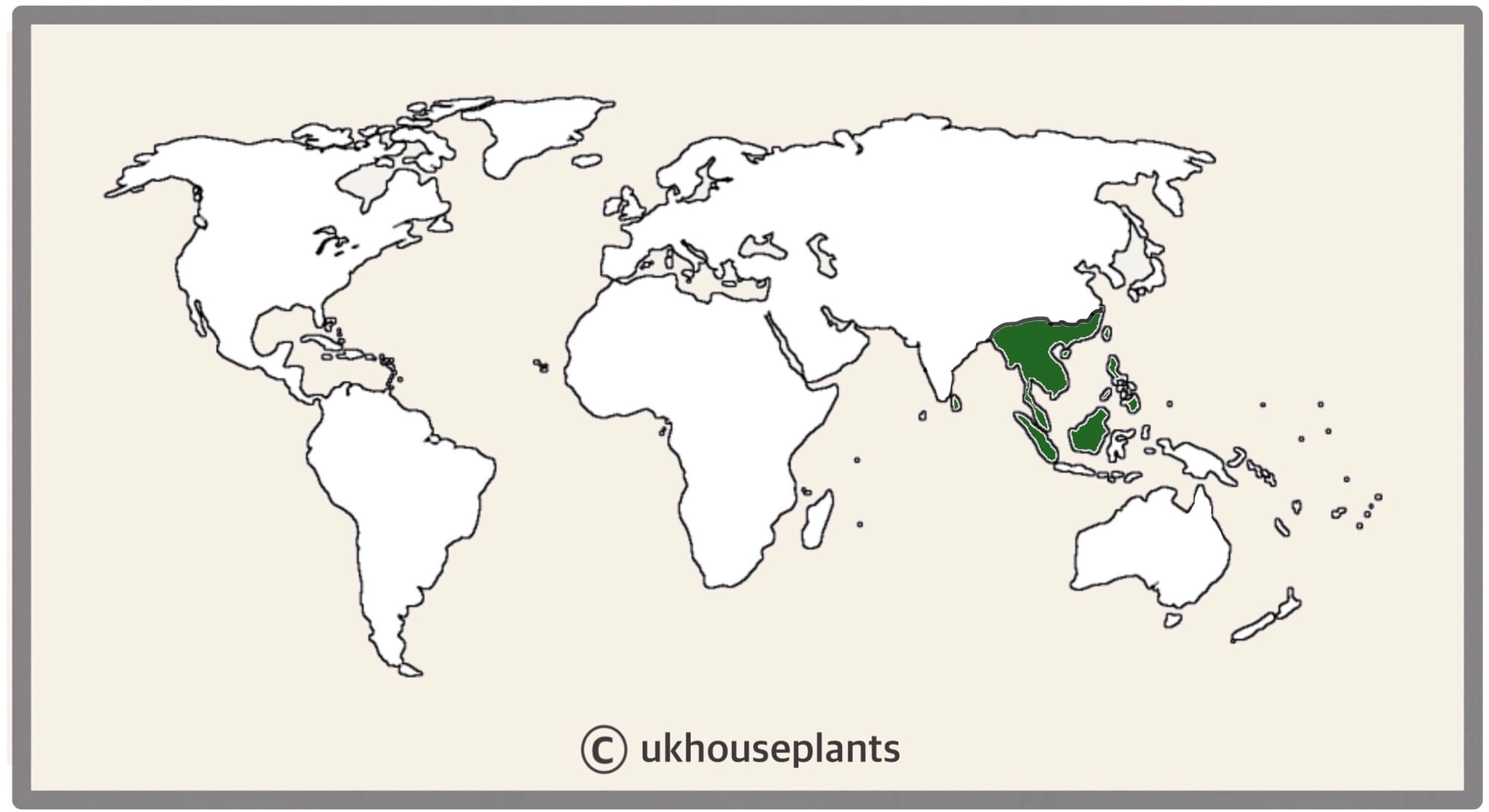 The Distribution of Ludisia discolor.
The Distribution of Ludisia discolor.
Temperature
12° - 25°C (54° - 78°F)
H1b (Hardiness Zone 12) - Can be grown outdoors during the summer in a sheltered location with temperatures above 13℃ (56℉), but is fine to remain indoors, too. If you decide to bring this plant outdoors, don't allow it to receive any direct sunlight as it may result in sun-scorch and dehydration. Regularly keep an eye out for pests, especially when re-introducing it back indoors.
Jewel Orchids will generally flower better in the winter months when the ambient temperature is dipped to around 15°C (59°F) during the autumn and winter.
Spread
Up to 0.3m in height and the width of its pot. The ultimate height will take between 4 - 6 years to achieve with around 5cm of new growth per season.
Pruning & Maintenance
Remove yellow or dying leaves, and plant debris to encourage better-growing conditions. While pruning, always use clean scissors or shears to reduce the chance of bacterial and fungal diseases. Never cut through yellowed tissue as this may cause further damage in the likes of diseases or bacterial infections. Remember to make clean incisions as too-damaged wounds may shock the plant, causing weakened growth and a decline in health. Remove spent flowers as they wilt and then the whole stalk once the show is over.
Propagation
Rhizomatous Stem Cuttings (Easy to Moderate) - During the spring, prune the tips of a few stems that have a slightly hardened base. Ideal cuttings should be at least 8cm (3 inches) in length and are found in the outer edge of the plant where the new growth takes place. Remove the older third of the leaves and submerge the rhizome loosely over a moist 'Houseplant' labelled soil or live Sphagnum Moss. Place the cuttings (& its pot) in a transparent bag with small holes to lock-in a steady level of humidity for the first month of its new life. Keep the soil evenly moist and present a bright, indirect location away from the harsh rays. After the initial month, remove the bag and follow the care requirements documented at the top of the article.
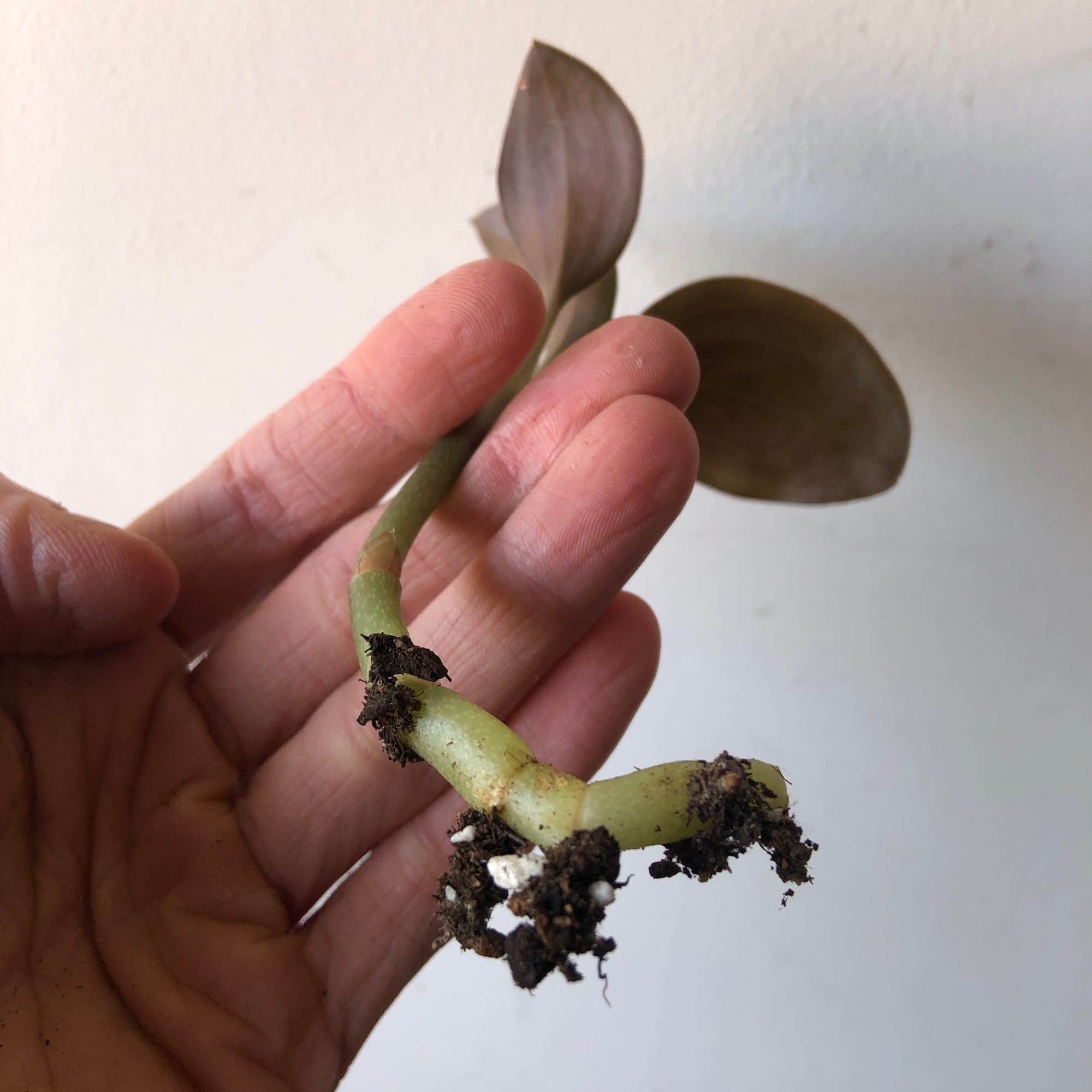 You can expect root development within four weeks of propagation.
You can expect root development within four weeks of propagation.
Flowers
Jewel Orchids will flower at the start of winter if grown correctly with a cooler environment during this time. Each individual flower will last up to ten days, with the overall show lasting up to five weeks. Feed the plant with a product high in potassium to prolong its flowers - 'Tomato' labelled fertiliser is an excellent choice. Never promote persistent droughts as this will shorten the duration of flowers.
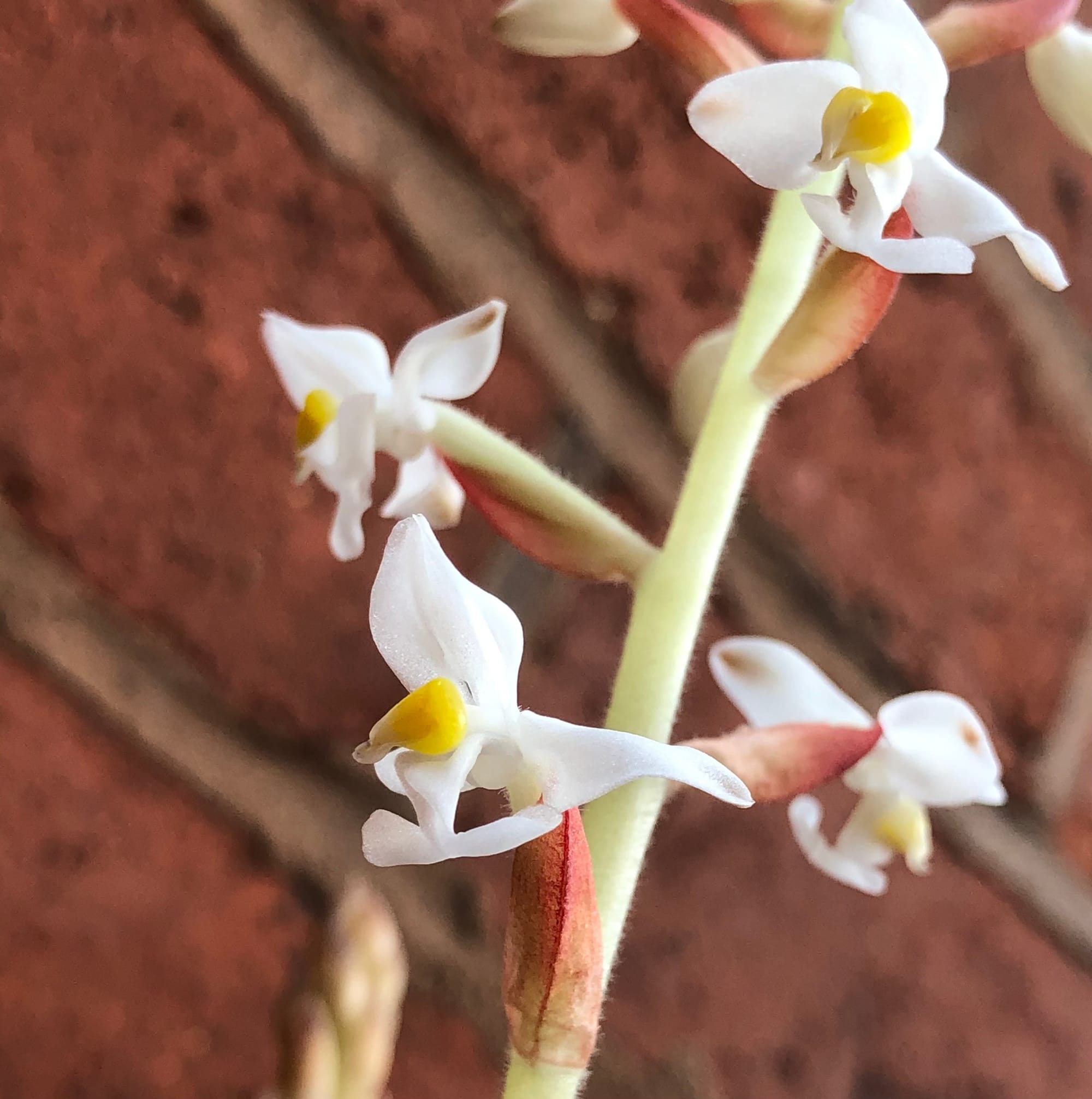 The individual flower of a Ludisia discolor will only measure around 2-3cm in diameter.
The individual flower of a Ludisia discolor will only measure around 2-3cm in diameter.
Repotting
Repot every three years in spring using a 'Houseplant' labelled and the next sized pot with adequate drainage. Jewel Orchids are best suited for pots that are wide and shallow, as their rhizomes will spread laterally as suppose to downwards. The ideal depth of a container should be around 5 inches (from the soil line downwards).
Hydrate the plant 24hrs before tinkering with the roots to prevent the risk of transplant shock. For those that are situated in a darker location, add a thin layer of small grit in the pot's base to improve drainage and downplay over-watering. Click here for a detailed step-by-step guide on transplantation, or via this link to learn about repotting with root rot.
Pests & Diseases
Keep an eye out for spider mites, thrips, aphids & mealybugs. Common diseases with Jewel Orchids are root or rhizome rot, powdery mildew, leaf-spot disease, botrytis petal blight and powdery mildew - click here to learn more about these issues.
Toxicity
Jewel Orchids aren't considered poisonous when consumed by pets and humans; however, when high quantities are eaten, it may result in vomiting, nausea and a loss of appetite.
Retail Locations
Online Stores.
Book a 1-to-1 Call with THE HOUSEPLANT DOCTOR™
If you need further advice with your houseplants, book an advice call with ukhouseplants' friendly and expert writer today! This can be done via a video or audio call on most apps, including Facebook, FaceTime & Skype. A ten-minute call costs £5.99 (US$7), or £15.99 for thirty minutes. You can ask multiple questions, including queries on plants, pests, terrariums, repotting advice and anything in between. Please consider supporting this service to keep ukhouseplants thriving!